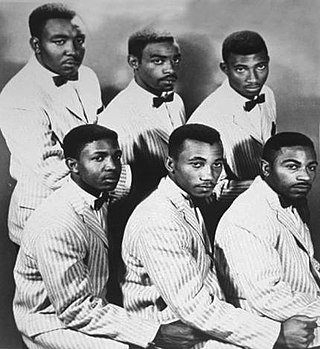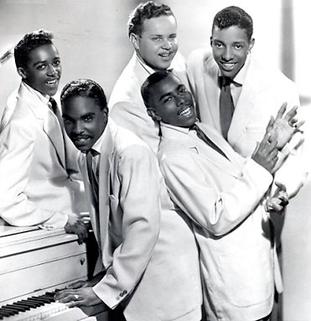The Penguins were an American doo-wop group from Los Angeles, California, that were active during the 1950s and early 1960s. They are known for their 1954 hit song, "Earth Angel", which was one of the first rhythm and blues songs to cross over to the pop charts. The song would ultimately prove to be their only success. The song peaked at No. 8 on the US Billboard Best Sellers in Stores pop chart but had a three-week run at No. 1 on the R&B chart.

Doo-wop is a genre of rhythm and blues music that originated in African-American communities during the 1940s, mainly in the large cities of the United States, including New York, Philadelphia, Pittsburgh, Chicago, Baltimore, Newark, Detroit, Washington, D.C., and Los Angeles. It features vocal group harmony that carries an engaging melodic line to a simple beat with little or no instrumentation. Lyrics are simple, usually about love, sung by a lead vocal over background vocals, and often featuring, in the bridge, a melodramatically heartfelt recitative addressed to the beloved. Harmonic singing of nonsense syllables is a common characteristic of these songs. Gaining popularity in the 1950s, doo-wop was "artistically and commercially viable" until the early 1960s, but continued to influence performers in other genres.

The Flamingos are an American doo-wop group formed in Chicago in 1953. The band became popular in mid-to-late 1950s and are known for their 1959 cover version of "I Only Have Eyes for You". They have since been hailed as one of the finest and most influential vocal groups in pop and doo wop music history. In 2001, the band was inducted into the Rock and Roll Hall of Fame.
The Orioles were an American R&B group of the late 1940s and early 1950s, one of the earliest such vocal groups who established the basic pattern for the doo-wop sound.
The Turbans were an American doo-wop vocal group that formed in Philadelphia, Pennsylvania in 1953. The original members were: Al Banks, Matthew Platt, Charlie Williams (baritone), and Andrew "Chet" Jones (bass). They came from Downtown Philadelphia.

The Crows were an American R&B singing group formed in 1951 who achieved commercial success in the 1950s. The group's first single and only hit, "Gee", released in June 1953, has been credited with being the first rock n’ roll hit by a rock and roll group. It peaked at position #14 and #2, respectively, on the Billboard magazine pop and rhythm-and-blues charts in 1954. Although Gee fell into the Doo Wop genre, and "was the first 1950s doo-wop record to sell over one million records" in that genre, some consider it as the first of the "rock n' roll records".

The Clovers are an American rhythm and blues/doo-wop vocal group who became one of the biggest selling acts of the 1950s. They had a top 30 US hit in 1959 with the Leiber and Stoller song "Love Potion No. 9".
The Mello-Moods were an American R&B musical ensemble, operating from the late 1940s to mid-1950s.
"Canadian Sunset" is a popular song with music by jazz pianist Eddie Heywood and lyrics by Norman Gimbel. An instrumental version by Heywood and Hugo Winterhalter reached No. 2 on the Billboard Hot 100 chart and No. 7 on the R&B chart in 1956. A version sung by Andy Williams was also popular that year, reaching No. 7 on the Billboard chart. The Sounds Orchestral, conducted by Johnny Pearson, hit the Easy Listening chart reaching No. 14 and the Billboard Hot 100 in 1965 reaching No. 76.

Maurice Williams and the Zodiacs were an American doo-wop/R&B vocal group in the late 1950s and early 1960s. Originally the (Royal) Charms, the band changed its name to the Gladiolas in 1957 and the Excellos in 1958, before finally settling on the Zodiacs in 1959.
The Edsels were an American doo-wop group from Campbell Ohio who were active during the late 1950s and early 1960s. The name of the group was originally The Essos, after the oil company, but was changed to match the new Ford automobile, the Edsel. They recorded over 25 songs and had multiple performances on Dick Clark's American Bandstand. The Edsels were one of the few doo-wop groups to sign with a major record label, as most groups of that era found success with small independent labels; before their national hit "Rama Lama Ding Dong", songs like "What Brought Us Together", "Bone Shaker Joe" and "Do You Love Me" helped the group land a major recording contract with Capitol Records in 1961.

"In the Still of the Nite", also subsequently titled "In the Still of the Night", is a song written by Fred Parris and recorded by his band the Five Satins. Originally the song was titled "(I'll Remember) In the Still of the Nite" to distinguish itself from Cole Porter's "In the Still of the Night". Later the title was changed to "In the Still of the Night".

The Chords were an American doo-wop vocal group formed in 1951 in The Bronx, New York, known for their 1954 hit "Sh-Boom", which they wrote. It is the only song they created that reached mainstream popularity.
The Danleers were an American doo-wop group formed in Brooklyn, New York in 1958. The group's original and most famous lineup consisted of Jimmy Weston, Johnny Lee, Willie Ephraim, Nat McCune, and Roosevelt Mays. One of many streetcorner vocal groups in Brooklyn, they rose to prominence in 1958 on the strength of the single "One Summer Night", written by their manager, Danny Webb, who also named the group. The single was one of the biggest hits of that year and sold over one million copies. Further releases were not so successful and the group mostly dissolved by the mid-1960s. It continued to tour for several decades with Weston as the main original member.
Otis Williams and the Charms were an American doo-wop vocal group in the 1950s, who were originally billed as The Charms. Williams is not related to Otis Williams of The Temptations.

The Solitaires were an American doo-wop group, best known for their 1957 hit single "Walking Along". Although they never had a national chart hit, they were one of the most popular vocal groups in New York in the late 1950s.
The Four Knights were an American vocal group from Charlotte, North Carolina, United States. Their 1954 hit, "I Get So Lonely When I Dream About You ", sold over one million copies and was awarded a gold disc.
The Students were an American doo-wop vocal group, which formed in Cincinnati, Ohio, United States, in 1957. Although they only released four sides, two of them – "I'm So Young" and "Every Day of the Week" – became doo-wop standards. "I'm So Young" in particular became popular and durable, and has been covered by the Beach Boys, Rosie and the Originals, The Ronettes and Kid Kyle and "The Students".

The Willows are an American doo-wop group formed in Harlem, New York, in 1952. The group was an influential musical act that performed into the mid-1960s and had a Top 20 R&B hit with "Church Bells May Ring", a song which was covered with greater commercial success by The Diamonds.
The Hollywood Saxons were a Los Angeles R&B group who recorded under various other names. They were well known on the LA R&B circuit. Their recording history ran from the late 1950s to the late 1960s. Their discography is complex due to the various names they recorded under and labels they recorded on.








